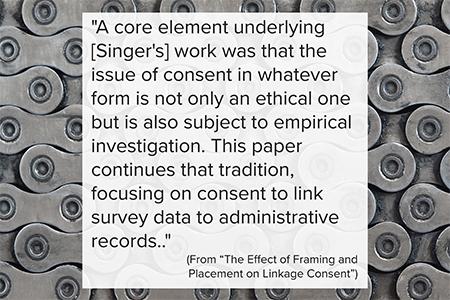September 18, 2019
Sakshaug, Couper, Singer and Colleagues Examine the Effects of Framing and Placement of Questions about Record Linkage on Linkage Consent Rates in Surveys
 Together with their international colleagues Alexandra Schmucker and Frauke Kreuter, adjunct Survey Methodology Program (SMP) faculty member and Program in Survey Methodology (PSM) graduate Joe Sakshaug, SRC Research Professor Mick Couper, and the late SRC Research Professor Eleanor Singer recently published a research note entitled 'The Effect of Framing and Placement on Linkage Consent' in a special issue of Public Opinion Quarterly. This special issue of POQ honored Eleanor's long history of excellent research contributions. This specific article by Sakshaug and colleagues emphasizes the importance of strategies for optimizing respondent consent to record linkage so that surveys can maximize the benefits of linking survey responses to external data sources, including administrative records.
Together with their international colleagues Alexandra Schmucker and Frauke Kreuter, adjunct Survey Methodology Program (SMP) faculty member and Program in Survey Methodology (PSM) graduate Joe Sakshaug, SRC Research Professor Mick Couper, and the late SRC Research Professor Eleanor Singer recently published a research note entitled 'The Effect of Framing and Placement on Linkage Consent' in a special issue of Public Opinion Quarterly. This special issue of POQ honored Eleanor's long history of excellent research contributions. This specific article by Sakshaug and colleagues emphasizes the importance of strategies for optimizing respondent consent to record linkage so that surveys can maximize the benefits of linking survey responses to external data sources, including administrative records.
The study described in the article featured a randomized experiment evaluating the effects of two critical factors in this process: the way that the question about record linkage is framed ('gain' framing, emphasizing the positive aspects of consenting to linkage, and 'loss' framing, emphasizing how the survey would be affected by a failure to consent), and where in the survey process the question is asked (at the beginning of the survey, or at the end). Respondents in two separate surveys (a telephone survey, n = 677; and a web survey, n = 651) were randomly assigned to one of four groups defined by the cross-classification of the two levels of each experimental factor.
The authors reported evidence of a significant interaction between the two factors in each survey. In the web survey, a significant positive effect of 'loss' framing was only found when the consent question was placed at the end of the questionnaire. In the telephone survey, the effect of 'loss' framing actually changed directions depending on placement: this type of framing had a negative effect on the consent rate when the question was placed at the beginning of the survey, and a positive effect when placed at the end of the survey. In both surveys, the placement effect was larger than the framing effect, where placement at the beginning of the survey was found to consistently increase consent rates. Overall, placement was found to be the most important factor, and the authors provided evidence of the importance of placing this question at the beginning of the survey, regardless of the survey mode.
This study was also unique in that the authors had access to administrative data for both individuals consenting to record linkage and individuals not consenting, enabling calculations of consent bias (and not just consent rates) associated with the two factors. The authors report that neither experimental factor affected consent bias in any meaningful way. Survey researchers working on surveys including this type of consent question should feel reassured by these findings.
Overall, this was a well-designed study that provides clear evidence in support of a design feature that survey researchers interested in record linkage can easily manipulate to optimize consent rates. The important and practical take-away points should appeal to survey researchers engaged in survey projects asking respondents to consent to record linkage.
Joseph W Sakshaug, Alexandra Schmucker, Frauke Kreuter, Mick P Couper, and Eleanor Singer (2019). The Effect of Framing and Placement on Linkage Consent. Public Opinion Quarterly, 83(S1): 289-308.